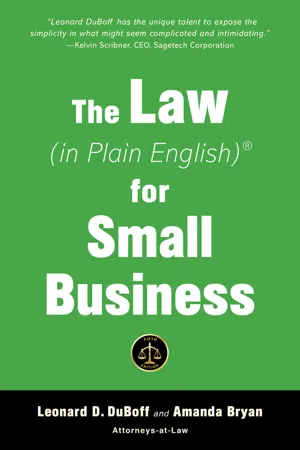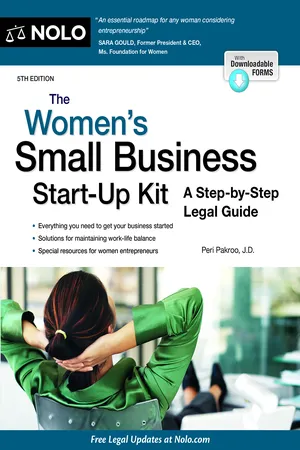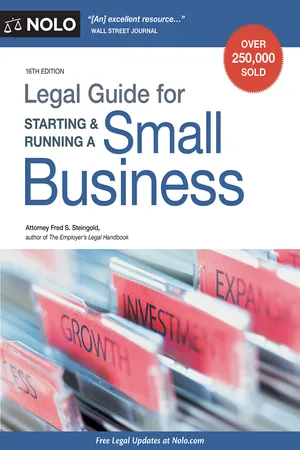Business
Forms of Business
Forms of business refer to the different legal structures through which businesses operate, such as sole proprietorships, partnerships, corporations, and limited liability companies. Each form has its own advantages and disadvantages in terms of liability, taxation, and management structure, allowing entrepreneurs to choose the most suitable option for their specific needs and goals.
Written by Perlego with AI-assistance
Related key terms
10 Key excerpts on "Forms of Business"
- No longer available |Learn more
- H. James Williams(Author)
- 2011(Publication Date)
- Collins Reference(Publisher)
Part 2: Business Formation and StructurePassage contains an image
CHAPTER 6
The Legal Forms of Business
A business is a legal entity, and as legal entities, businesses can be organized in a variety of legal forms. In the United States, the three most common types of business organizations are sole proprietorship, partnership (including the limited liability partnership), and corporation (including the limited liability corporation) (see Figure 6.1). Each of these three Forms of Business ownership has advantages and disadvantages that business owners must consider at the time the business is organized. These advantages and disadvantages, as well as the features of these different forms of organization, are detailed in the following sections.SOLE PROPRIETORSHIPSSole proprietorships are by far the most widely used business form in the world. Nearly 72 percent of all businesses in the United States are sole proprietorships; in fact, many of the largest companies in the country began as sole proprietorships. Although owned and managed by one person, the proprietorship may have many employees. Many local neighborhood businesses are sole proprietorships—retail, gift, floral, and shoe repair shops, for example—and are, therefore, owned by people who are self-employed.Advantages of Sole ProprietorshipsOne advantage of a sole proprietorship is the ease of starting the business. Unless the business requires a license, as some professions (doctors and lawyers) and trades (plumbers and electricians) do, sole proprietorships can usually be established simply by opening the door and doing business. Other advantages are the cost of organization, tax considerations, and the ease of dissolution (i.e., the cessation of business).Ease and Cost of OrganizationAgain, sole proprietorships are the easiest and least expensive Forms of Business to start. They demand no legal or organizational expenses. Frequently, the main investment is the labor and ability of the sole proprietor himself or herself. As long as the proposed activity is legal, anyone can start a sole proprietorship. - Leonard D. DuBoff, Amanda Bryan(Authors)
- 2019(Publication Date)
- Allworth(Publisher)
CHAPTER 1
Organizing Your Business
Everyone in business knows that survival requires careful financial planning, yet few fully realize the importance of selecting the best legal form for the business. Small businesses have little need for the sophisticated organizational structures utilized in large, publicly traded corporations, but since all entrepreneurs must pay taxes, obtain loans, and expose themselves to potential liability with every sale they make, it only makes sense to structure one’s business so as to address these issues.Every business has an organizational form best suited to it. When we counsel people on organizing their businesses, we usually adopt a two-step approach. First, we discuss various aspects of taxes and liability in order to decide which of the basic legal structures is best. There are only a handful of basic forms—the sole proprietorship, the partnership, the corporation, the limited liability company, the limited liability partnership, and a few hybrids. Once we have decided which of these is most appropriate, we go into the organizational documents such as partnership agreements, corporate bylaws, or operating agreements. These documents define the day-to-day operations of a business and must be tailored to individual situations.What we offer here is an explanation of the features of each of these kinds of organizations, including their advantages and disadvantages. This should give you an idea of which form might be best for your business. We will discuss potential problems, but, since we cannot go into a full discussion of the more intricate details, you should consult an experienced business attorney before deciding to adopt any particular structure. Our purpose is to facilitate your communication with your lawyer and to enable you to better understand the choices available.SOLE PROPRIETORSHIPSThe technical name sole proprietorship may be unfamiliar to you, but chances are you are operating under this form now. The sole proprietorship is an unincorporated business owned by one person. As a form of business, it is elegant in its simplicity. All it requires is a little money and work. Legal requirements are few and simple. Generally, all you need is a business license- eBook - ePub
Women's Small Business Start-Up Kit, The
A Step-by-Step Legal Guide
- Peri Pakroo(Author)
- 2018(Publication Date)
- NOLO(Publisher)
CHAPTER5
Understanding and Choosing a Legal Structure
Overview of Business Types Sole Proprietorships Pass-Through Taxation Personal Liability for Business Debts Partnerships General vs. Limited Partnerships Pass-Through Taxation Personal Liability for Business Debts Partnership Agreements Limited Liability Companies (LLCs) Limited Personal Liability LLC Taxation Forming an LLC Corporations Limited Personal Liability Corporate Taxation Forming and Running a Corporation Benefit Corporations, L3Cs, and Emerging Business Structures for Socially Conscious, Mission-Driven Businesses Benefit Corporations Certified B Corps Low-Profit Limited Liability Companies (L3Cs) Choosing the Best Legal Structure for Your BusinessChoosing a legal structure for your business is one of the first steps in transforming your idea into an actual, legitimate business. For some, this is a particularly exciting moment. For others, uncertainty about the legal ins and outs of business structures turn this into a stalling point. But take heart: For the vast majority of small to medium-size start-ups, there’s nothing terribly complicated about choosing and setting up the legal structure of the business.In all states, the basic types of business entities are: • sole proprietorships • partnerships (general and limited) • limited liability companies (LLCs), and • corporations (including C and S types).The differences among these types are fairly straightforward and easy to understand. In this chapter, I’ll explain the characteristics, benefits, and drawbacks of each type of business structure, and help you figure out which one is best for your business.TIPYou can change your business structure down the road, - eBook - ePub
- (Author)
- 2013(Publication Date)
- Wiley(Publisher)
3Business Start-up IssuesIf you are just starting a business, you have a lot of important decisions to make. If you’ve been in business for several years, there are a number of topics that you might revisit. This chapter covers topics such as legal structures for businesses, licenses and permits, taxes, and registering your business name.Learning Objective 1: Describe the various types of business legal structures.Learning Objective 2: Discuss the importance of business location and how it can affect ultimate success.Learning Objective 3: Describe how to package a loan request to your bank.Learning Objective 4: Explain the various tax laws and the importance of remaining legal and current in how you pay your taxes.Learning Objective 5: Discuss how to select and maintain strong vendor partners.CHOOSING THE BUSINESS LEGAL STRUCTURE
Choosing the Business Legal Structure- Sole proprietorship
- Partnership (limited or general)
- Corporation (S or C)
- Limited liability company
Type of Business: Quick Reference ListSole ProprietorshipThe sole proprietorship is the most common form of business organization. You own and operate the business and have sole responsibility and control. Essentially, you, the owner, are the business. The profits of the business are considered as personal income and, therefore, are taxed at your personal tax rate. - eBook - ePub
Construction Contracting
A Practical Guide to Company Management
- Richard H. Clough, Glenn A. Sears, S. Keoki Sears, Robert O. Segner, Jerald L. Rounds(Authors)
- 2015(Publication Date)
- Wiley(Publisher)
The typical Forms of Business ownership for construction contracting companies are the individual proprietorship, the partnership, and the corporation. Some of these basic forms of ownership have subsets or variations of the form they may take. A company owner's selection of the proper type of ownership for the business entity involves a great many considerations and is a matter that merits careful analysis and deliberative decision making. Each form of business organization has its own financial, taxation, and legal implications, all of which must be thoroughly investigated and understood. The selection of the ownership type that is most advantageous and appropriate for an owner's particular circumstances is a critically important business decision. As noted previously, this decision should only be made with the assistance and input of legal counsel, tax specialists, and business consultants when a new business is established or when consideration is being given to changing the form of ownership of an existing business concern.2.3 Construction Contracting Firms
The construction industry is one of the easiest of businesses to enter. Any interested person can get started with little or sometimes no capital investment. There are many large firms in the construction industry in the United States, but the large firms are far outnumbered by small and medium-size companies. Family-owned businesses that work close to home are the general rule.There are approximately 700,000 business firms in the United States that classify themselves as being construction contractors of one type or another. At any point in time, about 75 percent are individual proprietorships, 5 percent are partnerships, and 20 percent are corporations. Thus, it is easy to see that a large majority of construction firms are small businesses. However, it is also true that most of the very large construction firms in the United States, those that perform an annual volume of construction work of $100 million or more, are corporations.2.4 The Individual Proprietorship
The simplest form of ownership of a business entity is the individual proprietorship, also called sole ownership. Forming a sole proprietorship is the easiest and least expensive procedure for establishing and administering a business. Additionally, this form of business ownership enjoys a maximum degree of freedom from government regulation. No legal procedures are needed to go into business as a sole owner, except the obtaining of required insurance, registration with appropriate tax authorities and municipal and state government, and, in some jurisdictions, becoming licensed as a contractor. The owner has the choice of operating the business under his or her own name or under an assumed company name. In some jurisdictions, an assumed company name must be registered with a designated public authority, as a “doing business as (dba)” concern. - Fred S. Steingold, David Steingold(Authors)
- 2019(Publication Date)
- NOLO(Publisher)
Given the choice between creating an LLC or a corporation, many small business owners will be better off going the LLC route. For one thing, if your business will have several owners, the LLC can be more flexible than a corporation in the way you can parcel out profits and management duties. Also, setting up and maintaining an LLC can be a bit less complicated and expensive than a corporation. But there may be times a corporation will be more beneficial. For example, because a corporation—unlike other types of business entities—issues stock certificates to its owners, a corporation can be an ideal vehicle if you want to bring in outside investors or reward loyal employees with stock options.Keep in mind that your initial choice of a business form doesn’t have to be permanent. You can start out as sole proprietorship or partnership and, later, if your business grows or the risks of personal liability increase, you can convert your business to an LLC or a corporation.RELATED TOPICFor some small business owners, a less common type of business structure may be appropriate. While most small businesses will find at least one good choice among the four basic business formats described above, a handful will have special situations in which a different format is required or at least desirable. For example, a pair of dentists looking to limit their personal liability may need to set up a professional corporation or a professional limited liability company. A group of real estate investors may find that a limited partnership is the best vehicle for them. These and other special types of business organizations, including benefit corporations, are summarized at the end of this chapter.SEE AN EXPERTYou may need professional advice in choosing the best entity for your business. This chapter gives you a great deal of information to assist you in deciding how to best organize your business. Obviously, however, it’s impossible to cover every relevant nuance of tax and business law—especially if your business has several owners with different and complex tax situations. And for businesses owned by several people who have different personal tax situations, sorting out the effects of “pass-through” taxation (where partners and most LLC members are taxed on their personal tax returns for their share of business profits and losses) is no picnic, even for seasoned tax pros. The bottom line is that unless your business will start small and have a very simple ownership structure, before you make your final decision on a business entity, check with a tax adviser after learning about the basic attributes of each type of business structure (from this chapter and Chapters 2 , 3 , and 4- eBook - ePub
- Leonard D. DuBoff, Sarah J. Tugman(Authors)
- 2020(Publication Date)
- Allworth(Publisher)
limited liability company , and a few hybrids. Once the business form has been selected, there are organizational details, such as partnership agreements, operating agreements, or corporate papers to complete. These documents define the day-to-day operations of a business and, therefore, must be tailored to individual situations.An explanation of some of the features of these various business organizations, including their advantages and disadvantages, follows. This book cannot, and does not, include complete coverage of all of the pertinent details about business structures and their pros and cons. Each person’s personal circumstances are different and require consideration of individually relevant factors. As previously suggested, you should consult an attorney and an accountant before deciding to adopt any particular structure. This discussion is meant to facilitate your communication with your lawyer and to enable you to generally understand the choices available.THE AMERICAN DREAM: SOLE PROPRIETORSHIPThe technical name sole proprietorship may be unfamiliar to you, but you may be operating under this business form right now. A sole proprietorship is an unincorporated business owned by one person. Although not peculiar to the United States, it was, and still is, the backbone of the American dream. Legal requirements are few and simple. In many localities, professionals such as photographers are not required to have occupational licenses, while a business license is often required. If you wish to operate the business under a name other than your own, the name must be registered with the state or, in some cases, the county in which you are doing business.There are many financial risks involved in operating your business as a sole proprietor. If you recognize any of these dangers as a real threat, you probably should consider an alternative form of organization. If you are the sole proprietor of a business, the property you personally own is at stake. In other words, if for any reason you owe more than the dollar value of your business, your creditors can force a sale of much of your other personal property to satisfy the debt. Thus, if one of your photographs is defamatory, an invasion of someone’s privacy, or infringes someone else’s copyright, you could find that you are personally responsible for paying any judgment entered against you. - eBook - ePub
The Interior Design Business Handbook
A Complete Guide to Profitability
- Mary V. Knackstedt(Author)
- 2012(Publication Date)
- Wiley(Publisher)
S corporation. This corporation has the limited liability of a corporation, but the profits or losses of the business are passed through to the shareholders and taxed on the individual’s personal tax return. The S corporation itself does not pay any income taxes. There are restrictions and qualifications in order to establish an S corporation, so you should check with your tax advisor and attorney before settling on this form of business.3. Limited liability corporation (LLC). This corporation is similar to an S corporation, in which the shareholders have limited liability protection, and the profits/losses pass through to the shareholders individually. There are a couple of major differences. One is that an S corporation may be formed by one person, but in many states an LLC requires at least two. Also, S corporation profits/losses must be distributed according to each shareholder’s percent of ownership, but those of an LLC may be distributed according to a different plan. Again, you should consult with your tax advisor and attorney to determine the right structure for you.So many factors enter into the tax situation of a sole proprietorship, partnership, or corporation that it cannot be said unequivocally that any one form of business operation is more tax-advantageous than another. You and your accountant must review each situation separately and make projections about each of the various assumptions before deciding which structure is right for you. There are factors other than taxes to be considered in deciding which business structure is advisable for your situation. The tax implications, in fact, may be one of the least important considerations.Some of the other advantages and disadvantages of a corporate form of business as compared with a proprietorship or partnership are as follows. AdvantagesThe principal advantage is that a corporation has limited liability. Shareholders are liable for business debts only to the extent of their investments. There are more perks and fringe benefits available to the shareholder-employee. It is usually easier to transfer ownership. The shareholder needs only to assign stock certificate(s) to the new owner. This also facilitates the settlement of an estate upon the death of a shareholder. The business continues without being interrupted by the transfer of ownership. - Carrie de Silva, Jennifer Charlson, Carrie de Silva, Jennifer Charlson, Carrie de Silva, Jennifer Charlson(Authors)
- 2020(Publication Date)
- Routledge(Publisher)
5 Business organizations Carrie de SilvaSole trader
When persons want to set up in business, there is nothing to prevent them simply trading on their own account, with only their own money at risk. As such, the law would describe such a person as a sole trader. Trading in this way, however, may involve a number of drawbacks:- There may be lack of adequate funds to develop the business.
- There is no one to share responsibility for running the business.
- If the business gets into financial difficulties, the sole trader will have unlimited liability for its debts. Creditors will not be restricted to seizing the assets connected with the business. Even the person’s home may have to be sold.
Partnership
The sole trader may be able to overcome the first two of these disadvantages by forming a partnership. This relationship is described by the Partnership Act 1890 as ‘existing between persons who carry on business in common with a view to profit’. The arrangements for a partnership can be very informal, but it is advisable to have a properly drawn up agreement, in case disputes arise between the parties.Partnership is a suitable form of business association for professional people, e.g. accountants, architects, quantity surveyors and consulting engineers, although some such firms incorporate or, since 2000, have traded as limited liability partnerships (see below). Under the 1890 Act, all partners are legally entitled to take part in the running of the business, but in practice the parties can make whatever arrangements they like. All partners are agents of each other for the purposes of partnership business (e.g. making contracts, paying money and engaging staff on behalf of the firm). For this reason, it may be sensible to limit the number of partners. A partnership is often referred to as a firm, e.g. a firm of solicitors, but legally that term has no significance. The law is concerned to know: is this a partnership or a company? The word ‘firm’ might be equally appropriate to a firm of builder’s merchants trading as a limited company, but the legal consequences of dealing with a partnership and a company can be entirely different.- eBook - ePub
- Mohammed L. Ahmadu, Robert Hughes(Authors)
- 2017(Publication Date)
- Routledge-Cavendish(Publisher)
Some of what we will be examining in this book is of as much relevance to sole traders as it is to the combined commercial endeavours of groups of individuals. In this Part we will not be paying much attention to sole traders as commercial actors. Sole traders engage in commerce through entering into contracts of various kinds, just as do large corporations and commercial trusts. What we will do is focus on some of the major legal structures that exist as the basis for the carrying on of commercial activities. In some cases, for example with respect to companies, the structure involves the creation of what is in law a new individual or a new sole trader, viz the company itself. But companies also have features that compel us to recognise that they are associational structures, much as are partnerships. Trusts also in a sense involve, or can involve, an individual carrying on business on behalf of a trust, viz the trustee. But in such a case there will usually be other interests involved and these are the beneficiaries under the trust.Thus, in this Part we will pay no more attention to the single trader than to simply acknowledge that it is one basis for carrying on business. We will look at partnerships in Chapters 1 and 2 . In Chapters 3 and 4 we will look at the legal nature of trusts, particularly those used for carrying on business. In Chapters 5 and 6 we will examine the legal structure and methods of the creation of companies. Other associations such as cooperatives, friendly societies, banks and credit unions, and registered associations will provide the focus for Chapter 7 .Before proceeding further, let us look at some of the issues that arise in respect of the making of choices between these various legal structures for the conduct of commerce.The Structure of Commerce or Business
Promoters of new commercial ventures are presented with many options as to how they might legally structure the operation of their proposed commercial enterprise. It is a relatively basic principle of law that a person can select whatever structure or combination of structures they like. That is the case even though one structure might have very different taxation and different consequences from another. In relation to taxation there are different taxation regimes in relation to companies, trusts and partnerships. Opting for one structure will thus affect the taxation obligations both of the individual parties or investors and of the entity as a whole.
Index pages curate the most relevant extracts from our library of academic textbooks. They’ve been created using an in-house natural language model (NLM), each adding context and meaning to key research topics.









